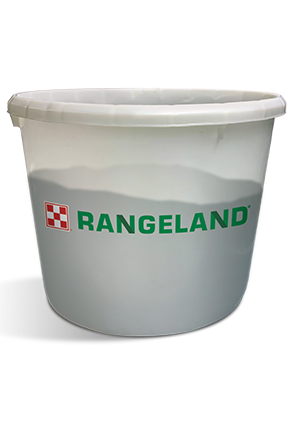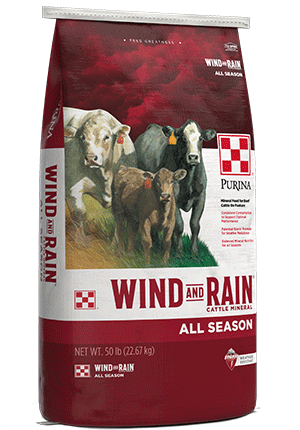
Best in Class Nutrition at Turner Shorthorns
Management : Cow & Calf
Nutrition : Minerals
Nutrition : Forage

Dr. Tom Turner is a retired Ohio State University beef cattle genetics professor, academic advisor and long-time livestock judging coach turned full-time cattleman.
He and his wife Susie currently manage Turner Shorthorns, home to about 60 purebred Shorthorn cattle and Shorthorn plus cattle.
Prior to Tom’s retirement in 2008, Turner Shorthorns was a focused, 20-cow hobby operation. Upon retirement, Turner Shorthorns expanded when the family purchased a new farm east of Columbus, Ohio.
You might wonder, why would the Turners spend retirement raising Shorthorn cattle? Tom’s answer is simple.
“It’s a stimulus for me. Susie and I enjoy the challenge of raising Shorthorn cattle,” says Tom. “It gets me up every morning and keeps my mind sharp.”
Soon after Turner Shorthorns’ herd expansion, the Turners had to tackle their first big challenge—improving their breeding results.
“We wanted to reduce the number of open cows we had after every breeding season,” says Tom. “Meanwhile, we wanted to tighten our calving window to 60 days to decrease labor requirements at Turner Shorthorns. We needed those cows to be cycling at the beginning of our breeding season.”
Because Turner Shorthorns mainly market calves to local youth as 4-H and FFA projects, the operation has a tight calf marketing window, typically nine or more months in advance of county fairs. It’s important for Turner Shorthorns to market calves at the right age during that tight window when youth make purchasing decisions.
To achieve these tight windows and overcome inconsistent forages, Turner Shorthorns uses the All Seasons™ Cattle Nutrition Program to provide cows with high-quality, year-round cattle nutrition.Leveling out cattle nutrition
Turner has struggled with inconsistent forage quality and quantity. Hay quality is no exception. He, like many Midwest producers, has dealt with hay quality issues due to extremely wet conditions. In addition, Tom’s cows primarily graze Kentucky 31 fescue, which is almost completely endophyte-infected.
Shortly after moving and expanding Turner Shorthorns in 2008, Tom established a relationship with local Purina dealer Granville Milling. John Reed, nutritionist and sales director at Granville Milling, helped develop a custom nutrition plan for Turner Shorthorns.
Now Tom doesn’t have to play a forage guessing game. He leans on Purina® RangeLand® Protein Tubs and Purina® Wind and Rain® Mineral to ensure his cows have access to the nutrition they need for breeding success.
“We started feeding RangeLand® Protein Tubs to provide our cows with consistent nutrition year-round,” Tom says. “Tub consumption varies depending on grass and hay quality, a sign the cows use those tubs to meet their needs.”
And the results are paying off.
“We think Purina Wind and Rain® Mineral and RangeLand® Protein Tubs support our breeding program and balances cattle nutrition,” says Tom. “Offering the best possible cattle nutrition helps ensure cows are in the right body condition pre-breeding and supports cows cycling at the beginning of breeding season.”
“Selling just one calf will pay for our cattle supplement cost for an entire year, based on our average calf price,” Tom says. “We think that's a pretty affordable investment if we can increase conception rates a few percentage points and get more live calves on the ground.”
Does your nutrition program stack up? Find out with a Proof Pays feeding trial.
He and his wife Susie currently manage Turner Shorthorns, home to about 60 purebred Shorthorn cattle and Shorthorn plus cattle.
Turner Shorthorns’ history
Shorthorn cattle run in Tom’s blood. He’s the third generation to raise Shorthorn cattle and is very involved in the cattle industry, currently serving on the American Shorthorn Association Board of Directors. Tom’s passion for the breed extended to his children, who grew up exhibiting at local and state cattle shows, as well as the annual National Junior Shorthorn Show.Prior to Tom’s retirement in 2008, Turner Shorthorns was a focused, 20-cow hobby operation. Upon retirement, Turner Shorthorns expanded when the family purchased a new farm east of Columbus, Ohio.
You might wonder, why would the Turners spend retirement raising Shorthorn cattle? Tom’s answer is simple.
“It’s a stimulus for me. Susie and I enjoy the challenge of raising Shorthorn cattle,” says Tom. “It gets me up every morning and keeps my mind sharp.”
Soon after Turner Shorthorns’ herd expansion, the Turners had to tackle their first big challenge—improving their breeding results.
“We wanted to reduce the number of open cows we had after every breeding season,” says Tom. “Meanwhile, we wanted to tighten our calving window to 60 days to decrease labor requirements at Turner Shorthorns. We needed those cows to be cycling at the beginning of our breeding season.”
Because Turner Shorthorns mainly market calves to local youth as 4-H and FFA projects, the operation has a tight calf marketing window, typically nine or more months in advance of county fairs. It’s important for Turner Shorthorns to market calves at the right age during that tight window when youth make purchasing decisions.
To achieve these tight windows and overcome inconsistent forages, Turner Shorthorns uses the All Seasons™ Cattle Nutrition Program to provide cows with high-quality, year-round cattle nutrition.
Leveling out cattle nutrition
Turner has struggled with inconsistent forage quality and quantity. Hay quality is no exception. He, like many Midwest producers, has dealt with hay quality issues due to extremely wet conditions. In addition, Tom’s cows primarily graze Kentucky 31 fescue, which is almost completely endophyte-infected.Shortly after moving and expanding Turner Shorthorns in 2008, Tom established a relationship with local Purina dealer Granville Milling. John Reed, nutritionist and sales director at Granville Milling, helped develop a custom nutrition plan for Turner Shorthorns.
Now Tom doesn’t have to play a forage guessing game. He leans on Purina® RangeLand® Protein Tubs and Purina® Wind and Rain® Mineral to ensure his cows have access to the nutrition they need for breeding success.
“We started feeding RangeLand® Protein Tubs to provide our cows with consistent nutrition year-round,” Tom says. “Tub consumption varies depending on grass and hay quality, a sign the cows use those tubs to meet their needs.”
And the results are paying off.
“We think Purina Wind and Rain® Mineral and RangeLand® Protein Tubs support our breeding program and balances cattle nutrition,” says Tom. “Offering the best possible cattle nutrition helps ensure cows are in the right body condition pre-breeding and supports cows cycling at the beginning of breeding season.”
An investment in cattle nutrition that’s worth it
Annual cow costs aren’t cheap and Tom knows it. As a cattleman driven by efficiency and productivity, Tom needs his cattle nutrition program at Turner Shorthorns to provide value.“Selling just one calf will pay for our cattle supplement cost for an entire year, based on our average calf price,” Tom says. “We think that's a pretty affordable investment if we can increase conception rates a few percentage points and get more live calves on the ground.”
Does your nutrition program stack up? Find out with a Proof Pays feeding trial.




